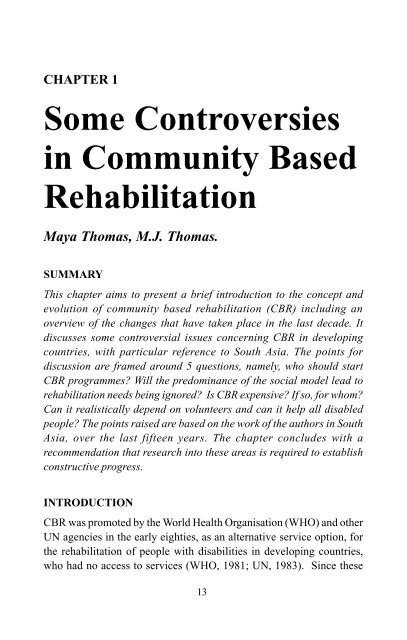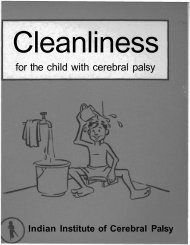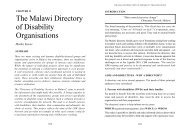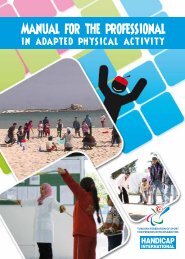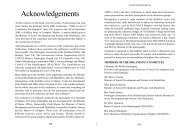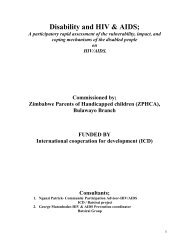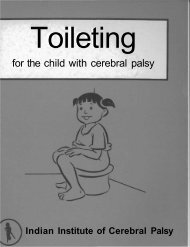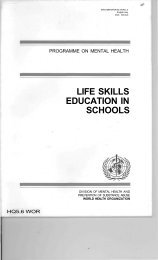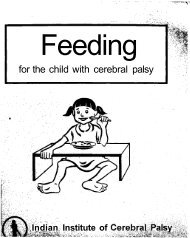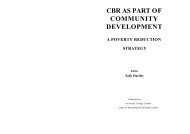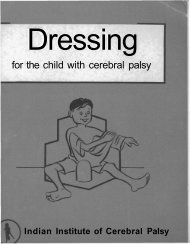Some Controversies in Community Based Rehabilitation - Source
Some Controversies in Community Based Rehabilitation - Source
Some Controversies in Community Based Rehabilitation - Source
You also want an ePaper? Increase the reach of your titles
YUMPU automatically turns print PDFs into web optimized ePapers that Google loves.
CHAPTER 1<br />
<strong>Some</strong> <strong>Controversies</strong><br />
<strong>in</strong> <strong>Community</strong> <strong>Based</strong><br />
<strong>Rehabilitation</strong><br />
Maya Thomas, M.J. Thomas.<br />
SUMMARY<br />
This chapter aims to present a brief <strong>in</strong>troduction to the concept and<br />
evolution of community based rehabilitation (CBR) <strong>in</strong>clud<strong>in</strong>g an<br />
overview of the changes that have taken place <strong>in</strong> the last decade. It<br />
discusses some controversial issues concern<strong>in</strong>g CBR <strong>in</strong> develop<strong>in</strong>g<br />
countries, with particular reference to South Asia. The po<strong>in</strong>ts for<br />
discussion are framed around 5 questions, namely, who should start<br />
CBR programmes Will the predom<strong>in</strong>ance of the social model lead to<br />
rehabilitation needs be<strong>in</strong>g ignored Is CBR expensive If so, for whom<br />
Can it realistically depend on volunteers and can it help all disabled<br />
people The po<strong>in</strong>ts raised are based on the work of the authors <strong>in</strong> South<br />
Asia, over the last fifteen years. The chapter concludes with a<br />
recommendation that research <strong>in</strong>to these areas is required to establish<br />
constructive progress.<br />
INTRODUCTION<br />
CBR was promoted by the World Health Organisation (WHO) and other<br />
UN agencies <strong>in</strong> the early eighties, as an alternative service option, for<br />
the rehabilitation of people with disabilities <strong>in</strong> develop<strong>in</strong>g countries,<br />
who had no access to services (WHO, 1981; UN, 1983). S<strong>in</strong>ce these<br />
13
CBR A PARTICIPATORY STRATEGY IN AFRICA<br />
countries had limited resources to provide high quality <strong>in</strong>stitutional<br />
services, the emphasis was on develop<strong>in</strong>g a method, which provided<br />
wide coverage, at costs that were affordable to the governments of these<br />
countries. In CBR, <strong>in</strong>terventions were to be shifted from <strong>in</strong>stitutions to<br />
the homes and communities of people with disabilities, and carried out<br />
by m<strong>in</strong>imally tra<strong>in</strong>ed people, such as families and other community<br />
members, thereby reduc<strong>in</strong>g the f<strong>in</strong>ancial costs (WHO, 1989).<br />
In the early eighties, CBR was conceptualised and evolved primarily as<br />
a service delivery method with a medical focus. WHO recommended<br />
that it be <strong>in</strong>tegrated <strong>in</strong>to the primary health care (PHC) system that was<br />
already well established <strong>in</strong> many develop<strong>in</strong>g countries. The International<br />
Classification of Impairments, Disabilities and Handicaps (ICIDH),<br />
published <strong>in</strong> 1980 by WHO, also encouraged a medical approach to<br />
rehabilitation (WHO, 1980). As a result, the early CBR programmes<br />
tended to focus on restor<strong>in</strong>g functional ability <strong>in</strong> disabled <strong>in</strong>dividuals,<br />
<strong>in</strong> order to ‘fit’ them <strong>in</strong>to their community. This was a sort of community<br />
located rehabilitation.<br />
Dur<strong>in</strong>g the eighties and the n<strong>in</strong>eties, there was a substantial growth <strong>in</strong><br />
the number of CBR programmes <strong>in</strong> different develop<strong>in</strong>g countries. Along<br />
with the quantitative growth, there were also major changes <strong>in</strong> the way<br />
it was conceptualised (Thomas and Thomas, 1999). One of the early<br />
changes was the shift from a medical focus to a more comprehensive<br />
approach. With the realisation that stand alone medical <strong>in</strong>terventions<br />
did not complete the rehabilitation process, CBR programmes gradually<br />
began to add on <strong>in</strong>terventions such as education, vocational tra<strong>in</strong><strong>in</strong>g,<br />
social rehabilitation and prevention. Along with this came the recognition<br />
that CBR needed to deal with issues relat<strong>in</strong>g to disabled people’s lives<br />
at all times, and to change not only the disabled <strong>in</strong>dividual, but the context<br />
<strong>in</strong> which he or she was located. Chang<strong>in</strong>g contextual factors <strong>in</strong>volves<br />
help<strong>in</strong>g non-disabled persons <strong>in</strong> the community accept people with<br />
disabilities, promote their social <strong>in</strong>tegration, and equalise their<br />
opportunities to access education and employment, <strong>in</strong> the same way as<br />
non-disabled persons. Protection of the rights of people with disabilities,<br />
14
SOME CONTROVERSIES IN CBR<br />
and empowerment of the community to manage their programmes are<br />
other aspects of the contextual changes. These require <strong>in</strong>volvement from<br />
the community, both before, dur<strong>in</strong>g and after the formal programme<br />
phase if a philosophy of susta<strong>in</strong>ability is to be embraced.<br />
Thus, CBR today, follows a social, rather than an exclusively medical<br />
model, but there are still many questions to be answered before CBR<br />
can be implemented effectively. It may need two or three more<br />
generations before CBR becomes part of the established culture and<br />
therefore susta<strong>in</strong>able. The follow<strong>in</strong>g discussion deals with some of the<br />
questions that need to be addressed.<br />
SHOULD CBR BE INITIATED EXTERNALLY BEFORE<br />
THE COMMUNITY EXPRESSES ITS NEEDS, OR ONLY<br />
WHEN THERE IS AN EXPRESSED NEED FROM THE<br />
COMMUNITY<br />
In the earlier years when CBR was a form of service delivery, this<br />
question was irrelevant. Today, however, CBR is viewed as a<br />
development process, and the question of whether CBR should be<br />
imposed by outsiders or <strong>in</strong>itiated by the community, is debated widely.<br />
In the earlier years, CBR tended to be a form of ‘community therapy’,<br />
where services were physically shifted to the community, but the clients<br />
rema<strong>in</strong>ed as passive ‘beneficiaries’ (Wirz, 2000). Subsequently, some<br />
CBR programmes have changed to a community development approach,<br />
where disabled persons and their families are actively <strong>in</strong>volved <strong>in</strong> all<br />
issues of concern to them. However, many feel that the <strong>in</strong>itiation of<br />
programmes rema<strong>in</strong>s <strong>in</strong> the hands of the ‘external’ facilitators because<br />
the level of awareness required for needs to be constructively expressed<br />
requires development, but that the ultimate goal should be full ownership<br />
of the programme by the clients. As it is conceptualised today,<br />
‘<strong>Community</strong> participation’ is a central and essential tenet of the social<br />
model of CBR. In practice, however, most CBR programmes <strong>in</strong> South<br />
Asia, f<strong>in</strong>d it difficult to achieve this goal (Thomas and Thomas, 2001)<br />
and the challenge of promot<strong>in</strong>g community <strong>in</strong>itiation rema<strong>in</strong>s.<br />
15
CBR A PARTICIPATORY STRATEGY IN AFRICA<br />
Usually, we assume that communities are homogeneous, cohesive and<br />
mutually supportive entities, but <strong>in</strong> reality, it does not appear to be so.<br />
They are, <strong>in</strong> most <strong>in</strong>stances, quite heterogeneous, with wide differences<br />
<strong>in</strong> socio-economic status, educational status, religion, ethnicity and so<br />
on (Boyce and Lysack, 2000). This diversity sometimes causes friction<br />
and affects services, because different groups <strong>in</strong> a community have widely<br />
differ<strong>in</strong>g needs and priorities. Usually the needs of disabled persons,<br />
who are <strong>in</strong> a m<strong>in</strong>ority, are not considered as a priority by others (Thomas<br />
and Thomas, 2001).<br />
Given this background, how does one def<strong>in</strong>e the ‘community’ <strong>in</strong> a CBR<br />
programme Does it comprise only of the primary clients, i.e. the people<br />
with disabilities and their families Or, does it <strong>in</strong>clude the larger<br />
community If the latter, is it reasonable to expect members of the<br />
community at large, to share their resources with disabled people<br />
Poverty is a major barrier to participation <strong>in</strong> development programmes,<br />
as people have other press<strong>in</strong>g needs to be fulfilled before they can take<br />
charge of their programmes. Corruption and corner<strong>in</strong>g of wealth by<br />
vested <strong>in</strong>terests is another issue that mitigates aga<strong>in</strong>st participation by<br />
all. People <strong>in</strong> develop<strong>in</strong>g countries also have difficulty with<br />
decentralisation and ‘bottom-up’ practices due to a cultural reluctance<br />
to take charge of their own affairs. Local communities usually expect<br />
benefits from the Government as a permanent dole, and resist suggestions<br />
about tak<strong>in</strong>g charge of programmes on their own (Thomas and Thomas,<br />
2000, Boyce and Lysack, 2000, Dalal, 1998).<br />
Consequently, the issue for debate among planners today, is whether<br />
CBR should be <strong>in</strong>itiated <strong>in</strong> a community by an external agency, or<br />
whether one should wait for the local communities to start CBR on their<br />
own The votaries of the former op<strong>in</strong>ion advocate start<strong>in</strong>g services for<br />
disabled <strong>in</strong>dividuals without wait<strong>in</strong>g for community participation, as it<br />
may take a long time, and <strong>in</strong> the meantime, the needs of many disabled<br />
persons would rema<strong>in</strong> ignored. They argue that community ownership<br />
of the programme, where people take on the responsibility for plann<strong>in</strong>g,<br />
implement<strong>in</strong>g, shar<strong>in</strong>g the risks of and monitor<strong>in</strong>g their programme, is<br />
16
SOME CONTROVERSIES IN CBR<br />
unlikely to be achieved <strong>in</strong> the foreseeable future. There is also a suspicion<br />
<strong>in</strong> the m<strong>in</strong>ds of many people, that the rhetoric of ‘community participation’<br />
is used by governments as a ploy to abdicate their responsibility, because<br />
the taxes collected are spent on causes other than development.<br />
The oppos<strong>in</strong>g argument is that CBR is a developmental issue and as<br />
such, it needs to be <strong>in</strong>itiated by the concerned groups themselves, who<br />
<strong>in</strong> this case are people with disabilities and their family members (Miles,<br />
1999, Werner, 1995). If it is externally <strong>in</strong>itiated, the clients will cont<strong>in</strong>ue<br />
to rema<strong>in</strong> passive recipients of services, with expectations of charity,<br />
and without the <strong>in</strong>itiative to manage their own affairs and to contribute<br />
to society.<br />
S<strong>in</strong>ce people <strong>in</strong> develop<strong>in</strong>g countries are largely ignorant about consumer<br />
ownership of development programmes, it is not feasible <strong>in</strong> most<br />
<strong>in</strong>stances to beg<strong>in</strong> the programme with full ownership by the communities<br />
(Thomas and Thomas, 2001). There is however, a possibility of strik<strong>in</strong>g<br />
a balance between the two oppos<strong>in</strong>g arguments. CBR programmes will<br />
need to motivate the local community to participate <strong>in</strong> their development<br />
to beg<strong>in</strong> with, and over time, to shoulder the responsibilities of the<br />
programme. In this process, the community will gradually acquire the<br />
management skills to take over their programmes as well (Thomas and<br />
Thomas, 2001).<br />
WILL THE SOCIAL MODEL OF CBR IGNORE THE ‘REAL<br />
REHABILITATION’ NEEDS OF PEOPLE WITH DISABILITIES<br />
When CBR was <strong>in</strong>itially promoted by WHO, it was to be <strong>in</strong>tegrated <strong>in</strong>to<br />
the PHC system, and thus many early CBR programmes followed a<br />
medical model, which came <strong>in</strong> for criticism <strong>in</strong> the eighties as not be<strong>in</strong>g<br />
sufficiently sensitive to all the needs of people with disabilities (Lang,<br />
2000). As a result, most CBR programmes evolved subsequently as<br />
separate programmes address<strong>in</strong>g an array of needs, <strong>in</strong> a comprehensive<br />
manner. The perception then, was that unless a special focus was given<br />
to disability, the ‘specialised’ needs of people with disabilities would<br />
rema<strong>in</strong> unmet (Thomas and Thomas, 1998). However, with the shift from<br />
17
CBR A PARTICIPATORY STRATEGY IN AFRICA<br />
a medical model to the social model, the emphasis today is on <strong>in</strong>tegrat<strong>in</strong>g<br />
disability <strong>in</strong>to development processes. Accord<strong>in</strong>g to votaries of this model,<br />
it is more cost-effective, and promotes better social <strong>in</strong>tegration, by ensur<strong>in</strong>g<br />
that people with disabilities have access to the same benefits and services<br />
as others <strong>in</strong> the community, unlike a ‘specialised’ CBR programme that<br />
concentrates on people with disabilities and may actually isolate them<br />
from the ma<strong>in</strong>stream (Scott, 1994). <strong>Community</strong> participation is likely to<br />
be greater <strong>in</strong> a programme that benefits the majority, rather than a m<strong>in</strong>ority<br />
group. At the same time, people fear that unplanned <strong>in</strong>tegration of<br />
disability <strong>in</strong>to other development programmes can ignore ‘real<br />
rehabilitation’ needs, such as mobility, special education, vocational<br />
rehabilitation and so on. In turn, this can contribute to <strong>in</strong>creased<br />
marg<strong>in</strong>alisation of people with disabilities, rather than their <strong>in</strong>tegration<br />
<strong>in</strong>to the ma<strong>in</strong>stream (Jones, 1999).<br />
The last few years have witnessed attempts to <strong>in</strong>tegrate disability <strong>in</strong>to<br />
community development projects that showed some tangible benefits<br />
for disabled people from the <strong>in</strong>tegration (Scott, 1994, Liton, 2000,<br />
Thomas, 2000). Many problems were also encountered <strong>in</strong> this process.<br />
Lack of organisational ability and knowledge about disability on the<br />
part of community development organisations, act as a major barrier to<br />
<strong>in</strong>tegration. Disability is seen as a ‘specialist’ issue, and hence these<br />
organisations feel that they do not have the expertise to deal with it<br />
(Jones,1999, Thomas, 2000). Further, disabled people tend to be<br />
recognised only by their disability and not by any other parameter, such<br />
as gender, poverty level, ethnic status and so on. This results <strong>in</strong> their<br />
exclusion from the benefits of <strong>in</strong>tegration <strong>in</strong> a development programme.<br />
Lack of mobility, education and skills <strong>in</strong> disabled people prevents them<br />
from be<strong>in</strong>g a part of development programmes, while expectations of<br />
charity and poor motivation on the part of disabled people, also<br />
contributes to their exclusion (Thomas, 2000).<br />
Integration of disability issues <strong>in</strong>to development programmes implies a<br />
high degree of co-ord<strong>in</strong>ation and collaboration between different sectors<br />
such as health, education, employment and so on. Often, such coord<strong>in</strong>ation<br />
works better at local, ‘grass-root’ levels, but fails at higher<br />
18
SOME CONTROVERSIES IN CBR<br />
regional or national levels. Difficulties <strong>in</strong> multi-sectoral collaborations<br />
can be due to many reasons. In develop<strong>in</strong>g countries, programmes tend<br />
to be ‘porous’ and as a result, the different players <strong>in</strong> the field take time<br />
to trust each other (Thomas and Thomas, 2001). Secondly, there are<br />
differences <strong>in</strong> the management culture of government organisations and<br />
non-governmental organisations (NGOs), with the government operat<strong>in</strong>g<br />
<strong>in</strong> a top-down manner while the NGOs are usually ‘bottom-up’ and<br />
democratic <strong>in</strong> their management style. These differences can become a<br />
barrier to effective collaboration. Thirdly, under the cover of<br />
‘collaboration’, members often try to ga<strong>in</strong> control over each other rather<br />
than to work towards a common goal, and hence multi-sectoral<br />
collaborations get submerged <strong>in</strong> power and control issues between the<br />
different sectors. Lack of commitment to the goal from all partners, can<br />
also be a problem <strong>in</strong> multi-sectoral collaborations. Usually, a powerful<br />
m<strong>in</strong>ority controls the process while the rest are passive participants. As<br />
a result, <strong>in</strong> many <strong>in</strong>stances the decisions are f<strong>in</strong>alised by the m<strong>in</strong>ority<br />
and the majority is left to merely endorse them.<br />
These issues need to be addressed and service development based on a<br />
comprehensive model, which <strong>in</strong>cludes both medical and social<br />
perspectives. This is more likely to meet the needs of disabled people.<br />
Until such time however, it may be more realistic to pursue a plan that is<br />
most feasible <strong>in</strong> a given context, focus<strong>in</strong>g on the goals of the programme<br />
as the central issue at all times.<br />
IS CBR INEXPENSIVE IF SO, FOR WHOM<br />
CBR was promoted to achieve wider coverage, at costs that are<br />
affordable. This was to be achieved by shift<strong>in</strong>g rehabilitation<br />
<strong>in</strong>terventions to families of disabled persons, thus reduc<strong>in</strong>g the f<strong>in</strong>ancial<br />
expenses on <strong>in</strong>stitutions and personnel, and consequently reduc<strong>in</strong>g the<br />
unit costs of rehabilitation. To date, very little evidence has been gathered<br />
to verify or reject the perception that CBR is a cheaper rehabilitation<br />
option particularly <strong>in</strong> remote rural sett<strong>in</strong>gs, where costs <strong>in</strong> terms of time<br />
and transport have to be considered.<br />
19
CBR A PARTICIPATORY STRATEGY IN AFRICA<br />
However, even if CBR does reduce the f<strong>in</strong>ancial costs of the service<br />
provider, a question, which must be addressed, is, who carries the burden<br />
then In reality, the costs to consumers <strong>in</strong> terms of their efforts, time and<br />
money, may turn out to be much higher than what it is generally believed<br />
to be (Thomas and Thomas, 1998). The ‘cost effective’ aspects of<br />
promot<strong>in</strong>g community-based <strong>in</strong>terventions lie <strong>in</strong> the utilisation of<br />
community resources. These, often <strong>in</strong>volve different community members<br />
who volunteer their time and efforts, to help and support disabled persons<br />
and their families. The volunteers are often family members themselves,<br />
<strong>in</strong> which case another aspect for consideration might be the ‘emotional<br />
cost’ of this <strong>in</strong>volvement. How to measure emotional costs, how to value<br />
or cost life itself, is difficult to contemplate, and how such <strong>in</strong>formation<br />
can be compared with a f<strong>in</strong>ancial budget seems an impossible task.<br />
The po<strong>in</strong>t then is, whether the consumers are ready to take on the<br />
additional burden of the costs of CBR <strong>in</strong>terventions Secondly, even if<br />
they are will<strong>in</strong>g to do so, can they afford to do so Many families <strong>in</strong><br />
develop<strong>in</strong>g countries, who are struggl<strong>in</strong>g for their daily survival, feel<br />
that it is a waste of effort and money to address the rehabilitation needs<br />
of their disabled children, preferr<strong>in</strong>g <strong>in</strong>stead, to spend on other children<br />
without disability <strong>in</strong> the hope that they would support them <strong>in</strong> their old<br />
age. In an environment of <strong>in</strong>creas<strong>in</strong>g competition for resources, their<br />
reason<strong>in</strong>g is that unless the other children are well placed, they may not<br />
be <strong>in</strong> a position to support their disabled sibl<strong>in</strong>g <strong>in</strong> the future, especially<br />
s<strong>in</strong>ce few protective social security schemes are available <strong>in</strong> these<br />
countries (Iyanar, 2001). Until some of these issues are addressed, it is<br />
unlikely that consumers would be ready to bear the costs of the<br />
rehabilitation programme on their own.<br />
IS CBR THE ANSWER FOR ALL DISABLED PEOPLE<br />
OR ONLY FOR A SELECT FEW<br />
It is estimated that 70% of people with disabilities could be helped at<br />
the community level, while the rema<strong>in</strong><strong>in</strong>g 30%, compris<strong>in</strong>g of people<br />
with severe and multiple disabilities, require specialist <strong>in</strong>terventions that<br />
are not available <strong>in</strong> the community (WHO, 1981). Evaluations of CBR<br />
20
SOME CONTROVERSIES IN CBR<br />
programmes <strong>in</strong> the eighties and early n<strong>in</strong>eties endorsed this view (Helander,<br />
1999). With the change towards a social model that emphasised equity<br />
and <strong>in</strong>tegration, CBR as it evolved subsequently, began to address the<br />
need to <strong>in</strong>clude all people with disabilities with<strong>in</strong> its ambit of services<br />
and <strong>in</strong>terventions. In reality, however, the desired level of equity has not<br />
been achieved, leav<strong>in</strong>g out some sections of people with disabilities.<br />
It is estimated that about 20% of the disabled population that requires<br />
<strong>in</strong>terventions from a CBR programme are people with severe disabilities,<br />
many of whom would also have multiple disabilities (Rajendra, 2001).<br />
In poorer communities, the percentage of people with severe disabilities<br />
is low, as the families may not seek help for their survival. In some<br />
communities, mortality of children with disabilities reaches almost 80%,<br />
lead<strong>in</strong>g to a ‘weed<strong>in</strong>g out’ phenomenon (Rajendra, 2001). However small<br />
their number may be, CBR programmes face many difficulties <strong>in</strong> deal<strong>in</strong>g<br />
with the impairment aspects of severe disabilities. Many programmes<br />
are <strong>in</strong>itiated by external agents, who need to build a rapport with the<br />
community and show quick results. They often achieve this by work<strong>in</strong>g<br />
with mildly and moderately disabled persons. As a result, people with<br />
severe disabilities tend to be left out of <strong>in</strong>terventions. Most CBR<br />
programmes also do not have personnel who are adequately tra<strong>in</strong>ed to<br />
deal with this group. <strong>Some</strong>times, <strong>in</strong> the process of promot<strong>in</strong>g ‘community<br />
participation’ and ‘rights’ of disabled persons, the impairment needs of<br />
severely disabled persons get neglected. As yet, there are no valid methods<br />
to effectively address the needs of this group at the community level.<br />
Women with disabilities are another group whose needs are not<br />
adequately addressed by CBR programmes, particularly <strong>in</strong> traditional<br />
cultures. Although disability leads to segregation of both men and<br />
women, women with disabilities face certa<strong>in</strong> unique disadvantages, such<br />
as difficulties <strong>in</strong> perform<strong>in</strong>g traditional gender roles, participat<strong>in</strong>g <strong>in</strong><br />
community life, and access<strong>in</strong>g rehabilitation services which are<br />
dom<strong>in</strong>ated by male service providers (Thomas, 2001). Concerns of<br />
women with disabilities also tend to get neglected, <strong>in</strong> organisations of<br />
people with disabilities that are usually dom<strong>in</strong>ated by disabled men. Even<br />
the women’s organisations <strong>in</strong> develop<strong>in</strong>g countries consider these women<br />
21
CBR A PARTICIPATORY STRATEGY IN AFRICA<br />
as disabled first and as women only secondarily. CBR programmes will<br />
need to develop appropriate strategies to address issues related to<br />
traditional, social and cultural perceptions. Strategies, such as awareness<br />
build<strong>in</strong>g, to dispel misconceptions about disabled women’s gender roles<br />
are needed, along with skills development tra<strong>in</strong><strong>in</strong>g, to carry out their<br />
tasks and home adaptation where feasible. Tra<strong>in</strong><strong>in</strong>g of women and CBR<br />
staff, provision of educational and employment opportunities for women<br />
with disabilities, sensitisation of women’s organisations and disabled<br />
persons’ organisations to <strong>in</strong>clude the issues of women with disabilities <strong>in</strong><br />
their agenda, can all help to reduce the <strong>in</strong>equality between women and<br />
men with disabilities.<br />
CAN VOLUNTEERS IN CBR ‘AFFORD’ TO VOLUNTEER<br />
In an <strong>in</strong>ternational workshop on CBR <strong>in</strong> 1998, participants from twentytwo<br />
CBR projects were asked to identify the major challenges fac<strong>in</strong>g them.<br />
Problems l<strong>in</strong>ked to community volunteers were identified as one of the<br />
significant issues by almost all of the participants. The problems had to<br />
do with difficulty <strong>in</strong> f<strong>in</strong>d<strong>in</strong>g new community volunteers, fast turnover of<br />
volunteers, need for additional resources for cont<strong>in</strong>uously tra<strong>in</strong><strong>in</strong>g new<br />
volunteers, lack of motivation among volunteers, and need for pay<strong>in</strong>g<br />
<strong>in</strong>centives or small salaries to volunteers (Deepak and Sharma, 2001).<br />
The role of community volunteers is perceived as one of the major issues<br />
for CBR projects <strong>in</strong> different parts of the world, particularly <strong>in</strong> the light<br />
of the current emphasis on ‘community participation’. There are examples<br />
of CBR programmes that have successfully used volunteers (O’Toole,<br />
1995), but these are probably the exception, rather than the rule.<br />
The po<strong>in</strong>t of debate is, can there be true voluntarism <strong>in</strong> develop<strong>in</strong>g<br />
countries where a majority of the population cannot afford to ‘volunteer’<br />
The dictionary def<strong>in</strong>es ‘volunteer’ as a person, ‘who voluntarily<br />
undertakes, or expresses a will<strong>in</strong>gness to undertake a service while hav<strong>in</strong>g<br />
no legal concern or <strong>in</strong>terest’. Thus, the term has a dual connotation, that<br />
of, ‘own free will’ and of ‘without <strong>in</strong>terest or payment’. Though the term<br />
‘volunteer’ is used often <strong>in</strong> CBR, <strong>in</strong> reality, it covers a variety of identities<br />
and roles that do not conform to the def<strong>in</strong>ition of the term (24). Thus,<br />
22
SOME CONTROVERSIES IN CBR<br />
there may be persons who have the time to dedicate to their chosen task,<br />
or may have some time <strong>in</strong> specific periods of the month or year, or may<br />
be available only for a limited period of time. In the last decade, with a<br />
move to market economies <strong>in</strong> many develop<strong>in</strong>g countries, most people<br />
need paid employment to survive and are therefore less able or will<strong>in</strong>g to<br />
volunteer. Those who do volunteer, often use their tra<strong>in</strong><strong>in</strong>g and experience<br />
as a stepp<strong>in</strong>g-stone to paid employment. Under these circumstances,<br />
expectations of free work over a long period of time from volunteers, <strong>in</strong><br />
the same way as paid CBR workers, may not be realistic or susta<strong>in</strong>able.<br />
CONCLUSION<br />
After more than two decades of CBR <strong>in</strong> different parts of the world,<br />
many people believe that it may be an appropriate approach for people<br />
with disabilities, <strong>in</strong> develop<strong>in</strong>g countries. But many controversies and<br />
questions rema<strong>in</strong> about different aspects of CBR. If sufficient attention<br />
and resources are allocated to research <strong>in</strong> this field, it is possible that<br />
some of these questions may be answered <strong>in</strong> the com<strong>in</strong>g decade.<br />
REFERENCES<br />
BOYCE, W. & LYSACK, L. (2000). <strong>Community</strong> Participation : Uncover<strong>in</strong>g<br />
its Mean<strong>in</strong>gs <strong>in</strong> CBR. <strong>in</strong> Thomas M, Thomas M.J. (eds) Selected Read<strong>in</strong>gs<br />
<strong>in</strong> <strong>Community</strong> <strong>Based</strong> <strong>Rehabilitation</strong> Series 1, Bangalore, pp 39-54.<br />
DALAL, A. (1998). CBR <strong>in</strong> Action - <strong>Some</strong> Reflections from the Sirathu Project.<br />
Asia Pacific Disability <strong>Rehabilitation</strong> Journal, 9(1), pp 29-31.<br />
DEEPAK, S. & SHARMA, M. (2001). Volunteers and <strong>Community</strong> <strong>Based</strong><br />
<strong>Rehabilitation</strong>. Asia Pacific Disability <strong>Rehabilitation</strong> Journal 12(2), pp<br />
141-148.<br />
HELANDER, E. (1999). Prejudice and Dignity. UNDP: New York.<br />
IYANAR, J. (2001). Listen<strong>in</strong>g to Different Voices - Inclusion and Exclusion<br />
of People with Disabilities <strong>in</strong> Education. Asia Pacific Disability<br />
<strong>Rehabilitation</strong> Journal 12(2). pp 155-159.<br />
JONES, H. (1999). Integrat<strong>in</strong>g a Disability Perspective <strong>in</strong>to Ma<strong>in</strong>stream<br />
23
CBR A PARTICIPATORY STRATEGY IN AFRICA<br />
Development Programmes : The Experience of Save the Children (UK)<br />
<strong>in</strong> East Asia, <strong>in</strong> Stone E. (ed) Disability and Development, Leeds, The<br />
Disability Press.<br />
LANG, R. (2000). The Role of NGOs <strong>in</strong> the Process of Empowerment and<br />
Social Transformation of People with Disabilities, <strong>in</strong> Thomas M, Thomas<br />
MJ (eds) Selected Read<strong>in</strong>gs <strong>in</strong> <strong>Community</strong> <strong>Based</strong> <strong>Rehabilitation</strong><br />
Series 1, Bangalore, India<br />
LITON, S.A. (2000). Integrat<strong>in</strong>g People with Disabilities <strong>in</strong>to Development<br />
Programmes: <strong>Some</strong> Lessons from Oxfam - Bangladesh. Asia Pacific<br />
Disability <strong>Rehabilitation</strong> Journal 11(1), pp 34-35.<br />
MILES, S. (1999). Strengthen<strong>in</strong>g Disability and Development Work. Discussion<br />
Paper, British Organisation of NGOs for Development, London.<br />
O’TOOLE, B. (1995). Mobilis<strong>in</strong>g Communities <strong>in</strong> Guyana. <strong>in</strong> O’Toole B,<br />
McConkey R. (eds) Innovations <strong>in</strong> Develop<strong>in</strong>g Countries for People with<br />
Disabilities. Lisieux Hall, Chorley, UK.<br />
RAJENDRA, K.R. (2001). Tra<strong>in</strong><strong>in</strong>g Needs <strong>in</strong> CBR <strong>in</strong> South Asia with Special<br />
Reference to Severe Disabilities, Inclusiveness and the Integrated<br />
Approach. Friday Meet<strong>in</strong>g Transactions 3(1), pp18-23.<br />
SCOTT, H. (1994). <strong>Community</strong> <strong>Based</strong> <strong>Rehabilitation</strong> Programmes <strong>in</strong><br />
Develop<strong>in</strong>g Countries - <strong>Some</strong> Examples of Methods. Actionaid Disability<br />
News 5 (1), pp 51-56.<br />
THOMAS, M. & THOMAS, M.J. (1998). <strong>Controversies</strong> on <strong>Some</strong> Conceptual<br />
Issues <strong>in</strong> <strong>Community</strong> <strong>Based</strong> <strong>Rehabilitation</strong>. Asia Pacific Disability<br />
<strong>Rehabilitation</strong> Journal 9(1), pp 12-14.<br />
THOMAS, M. & THOMAS, M.J. (1999). A Discussion on the Shifts and<br />
Changes <strong>in</strong> <strong>Community</strong> <strong>Based</strong> <strong>Rehabilitation</strong> <strong>in</strong> the Last Decade, Neuro<br />
<strong>Rehabilitation</strong> and Neural Repair, 13, pp 185-189.<br />
THOMAS, M. & THOMAS, M.J. (2001). Plann<strong>in</strong>g for ‘<strong>Community</strong><br />
Participation’ <strong>in</strong> CBR. Asia Pacific Disability <strong>Rehabilitation</strong> Journal,<br />
12(1):44-51.<br />
THOMAS, M. & THOMAS, M.J. (2001). Feasibility of Establish<strong>in</strong>g a CBR<br />
24
SOME CONTROVERSIES IN CBR<br />
Tra<strong>in</strong><strong>in</strong>g Institute Through Local Collaboration. Asia Pacific Disability<br />
<strong>Rehabilitation</strong> Journal 12(2), pp131-140.<br />
THOMAS, M. (2000). Feasibility of Integrat<strong>in</strong>g People with Disabilities <strong>in</strong><br />
Sav<strong>in</strong>gs and Credit Programmes <strong>in</strong> Bangladesh. Asia Pacific Disability<br />
<strong>Rehabilitation</strong> Journal 11(1), pp 27-31.<br />
THOMAS, M. (2001). Status of Women with Disabilities <strong>in</strong> South Asia. Friday<br />
Meet<strong>in</strong>g Transactions 3(1), pp 5- 8.<br />
UNITED NATIONS (UN) (1983). World Programme of Action Concern<strong>in</strong>g<br />
Disabled Persons, New York.<br />
WERNER, D. (1995). Strengthen<strong>in</strong>g the Role of Disabled People <strong>in</strong> <strong>Community</strong><br />
<strong>Based</strong> <strong>Rehabilitation</strong> Programmes, <strong>in</strong> O’Toole B, McConkey R. (eds)<br />
Innovations <strong>in</strong> Develop<strong>in</strong>g Countries for People with Disabilities, Lisieux<br />
Hall, Chorley, UK.<br />
WIRZ, S. (2000). Tra<strong>in</strong><strong>in</strong>g of CBR Personnel, <strong>in</strong> Thomas M, Thomas MJ<br />
(eds) Selected Read<strong>in</strong>gs <strong>in</strong> <strong>Community</strong> <strong>Based</strong> <strong>Rehabilitation</strong> Series 1,<br />
Bangalore, pp 96-108<br />
WORLD HEALTH ORGANISATION (1980). The International Classification<br />
of Impairments, Diseases and Handicaps, Geneva.<br />
WORLD HEALTH ORGANISATION (1981). Disability Prevention and<br />
<strong>Rehabilitation</strong>. Technical Report Series 668. Geneva.<br />
WORLD HEALTH ORGANISATION (1989). Tra<strong>in</strong><strong>in</strong>g <strong>in</strong> the <strong>Community</strong> for<br />
People with Disabilities, Geneva.<br />
25


